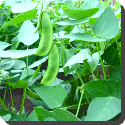 Lima Bean — P. lunatus is a legume. It is grown for its seed, which is eaten as a vegetable. It is commonly known as the lima bean or butter bean; it is also known as Haba bean, Pallar bean, Burma bean, Guffin bean, Hibbert bean, Java bean, Sieva bean, Rangood bean, Madagascar bean, Paiga, Paigya, prolific bean, civet bean and sugar bean.
Lima Bean — P. lunatus is a legume. It is grown for its seed, which is eaten as a vegetable. It is commonly known as the lima bean or butter bean; it is also known as Haba bean, Pallar bean, Burma bean, Guffin bean, Hibbert bean, Java bean, Sieva bean, Rangood bean, Madagascar bean, Paiga, Paigya, prolific bean, civet bean and sugar bean.
The P. lunatus is of Andean and Mesoamerican origin. Two separate domestication events are believed to have occurred. The first, taking place in the Andes around 2000 BC[citation needed], produced a large-seeded variety (Lima type), while the second, taking place most likely in Mesoamerica around 800 AD, produced a small-seeded variety (Sieva type). By 1301 AD, cultivation had spread to North America, and in the sixteenth century the plant arrived and began to be cultivated in the Eastern Hemisphere.
The small-seeded wild form (Sieva type) is found distributed from Mexico to Argentina, generally below 1600 meters above sea level, while the large-seeded wild form (Lima type)is found distributed in the north of Peru, between 320 and 2030 meters above sea level.
During the Spanish Viceroyalty of Peru, lima beans were exported to the rest of the Americas and Europe, since the boxes of such goods had their place of origin labeled “Lima – Peru”, the beans got named as such.
Both bush and pole (vine) varieties exist, the latter from one to four meters in height. The bush varieties mature earlier than the pole varieties. The pods are up to 15 cm long. The mature seeds are 1 to 3 cm long and oval to kidney shaped. In most varieties the seeds are quite flat, but in the “potato” varieties the shape approaches spherical. White seeds are common, but black, red, orange and variously mottled seeds are also known. The immature seeds are uniformly green.
The term butter bean is widely used for a large, flat, and white variety of lima bean (P. lunatus var. macrocarpus, or P. limensis[1]), however, in the Southern United States the Sieva type are traditionally called butter beans, also otherwise known as the Dixie or Henderson type. In that area, Lima beans and butter beans are seen as two distinct types of beans. In the United Kingdom, a “butter bean” is a dried bean which can be purchased either to re-hydrate (in the same manner as dried peas) or as canned (tinned) and ready to use. In culinary use, lima beans and butter beans are distinctly different, the former being small and green, the latter large and yellow.
 Kids Portal For Parents India Kids Network
Kids Portal For Parents India Kids Network






